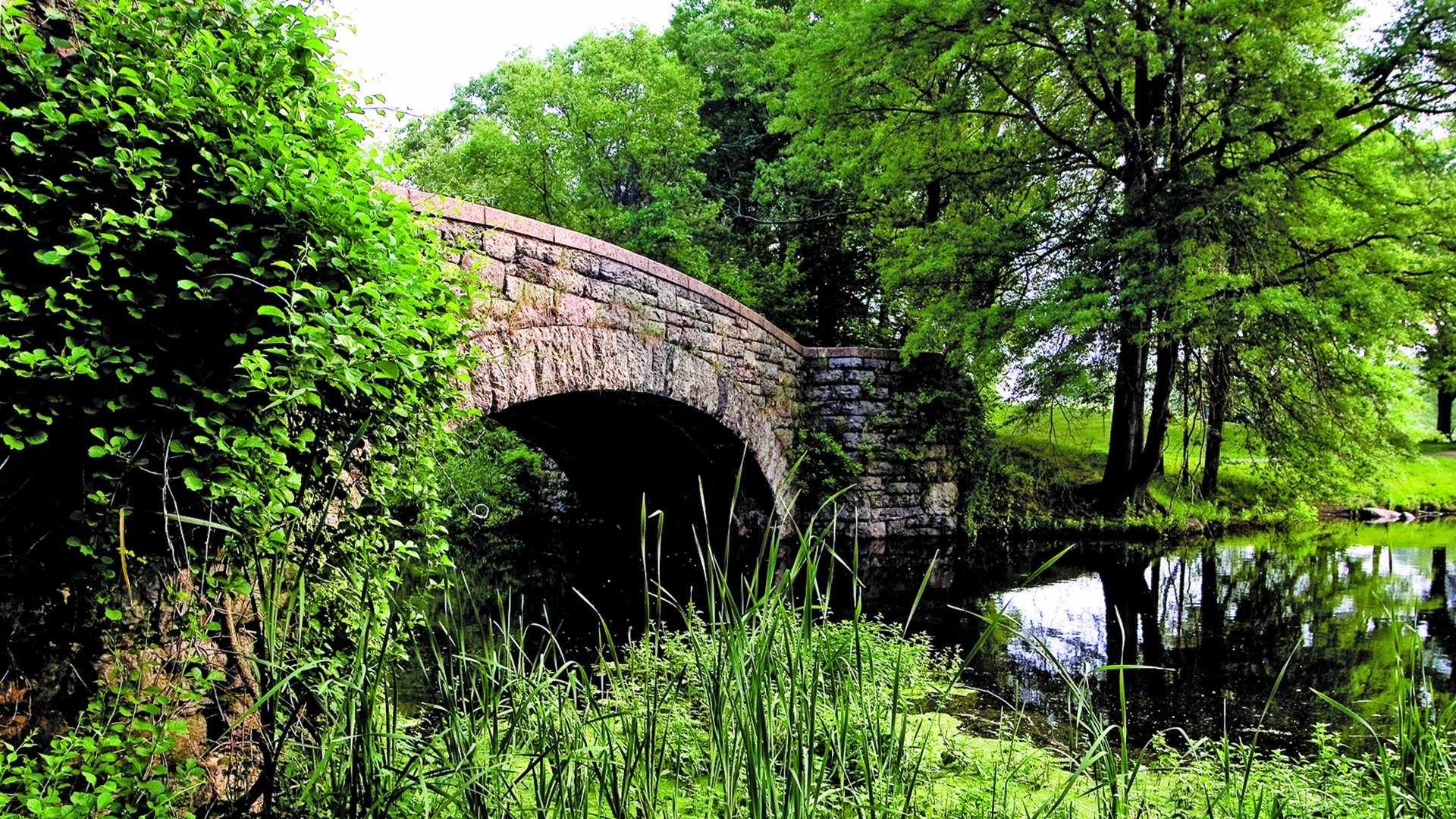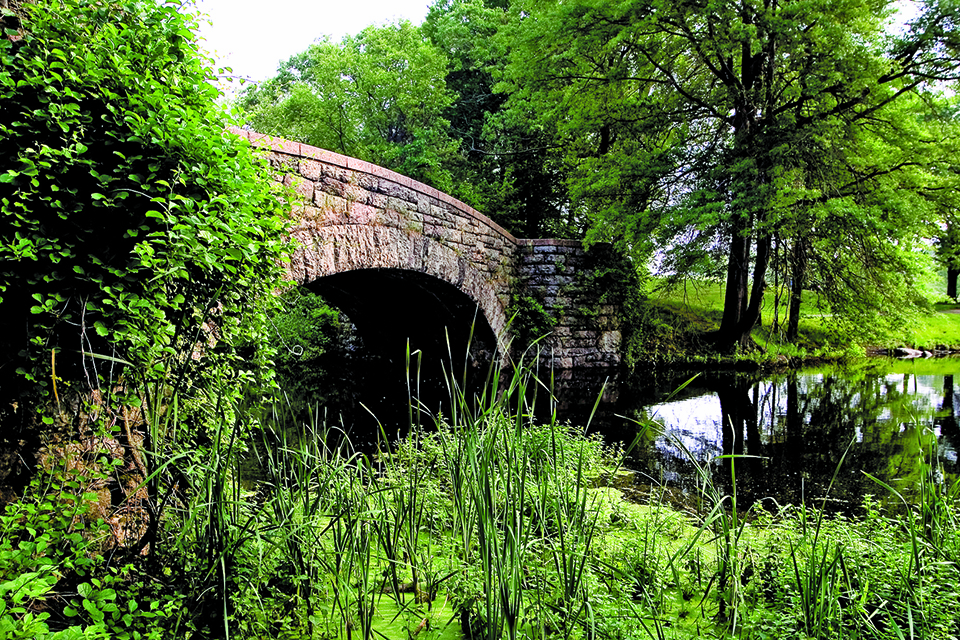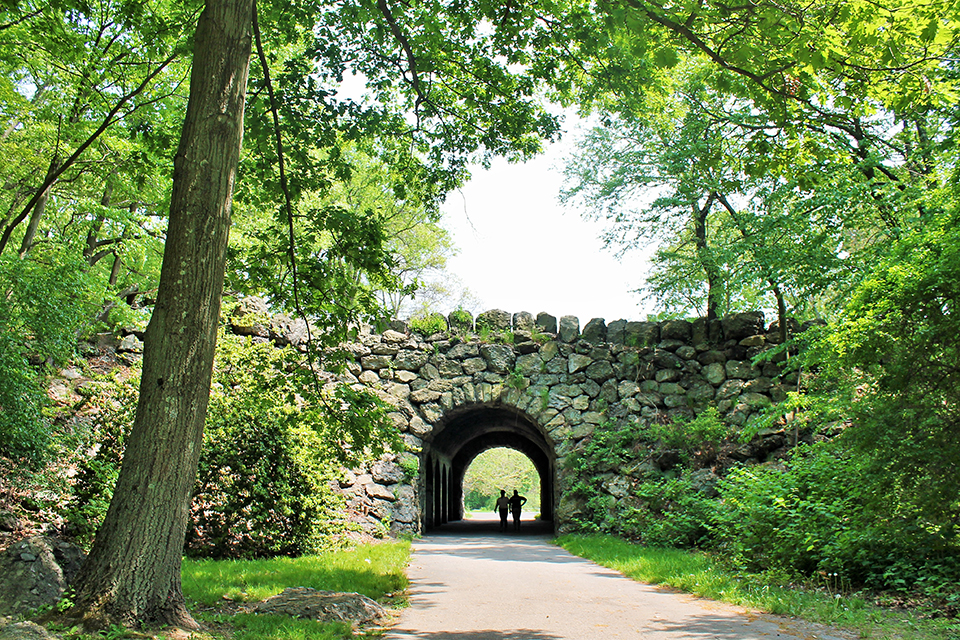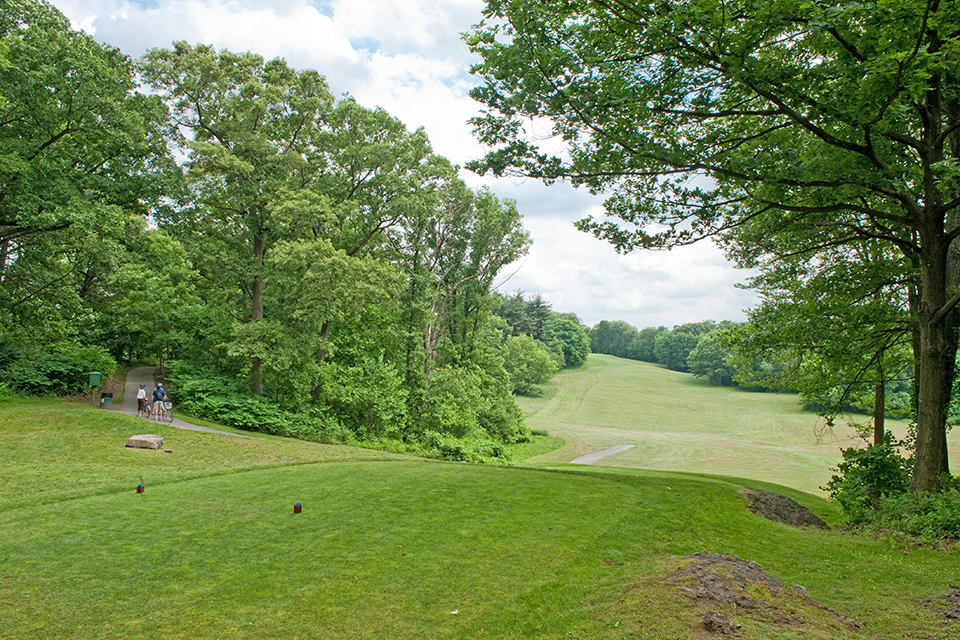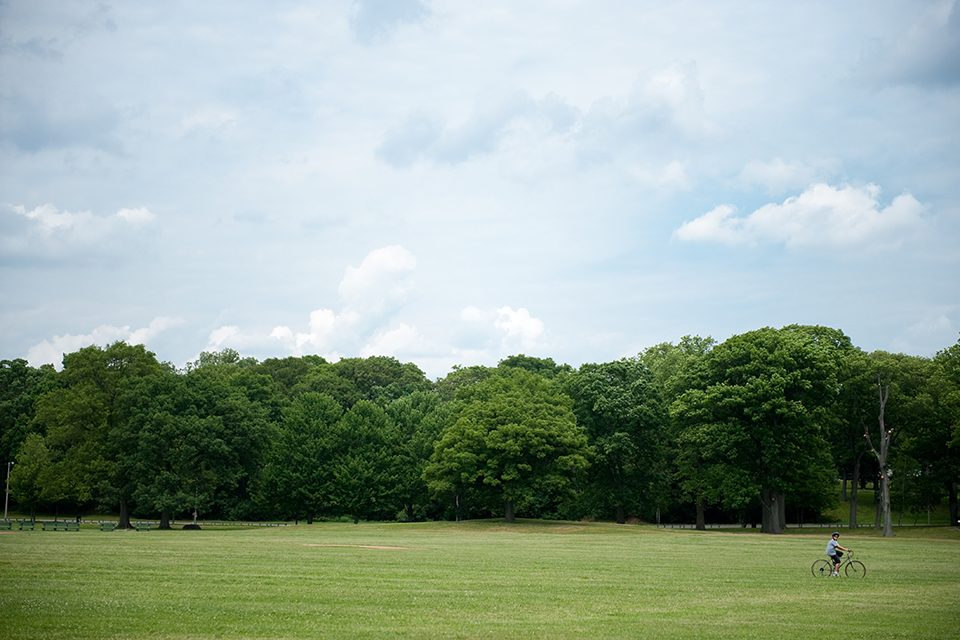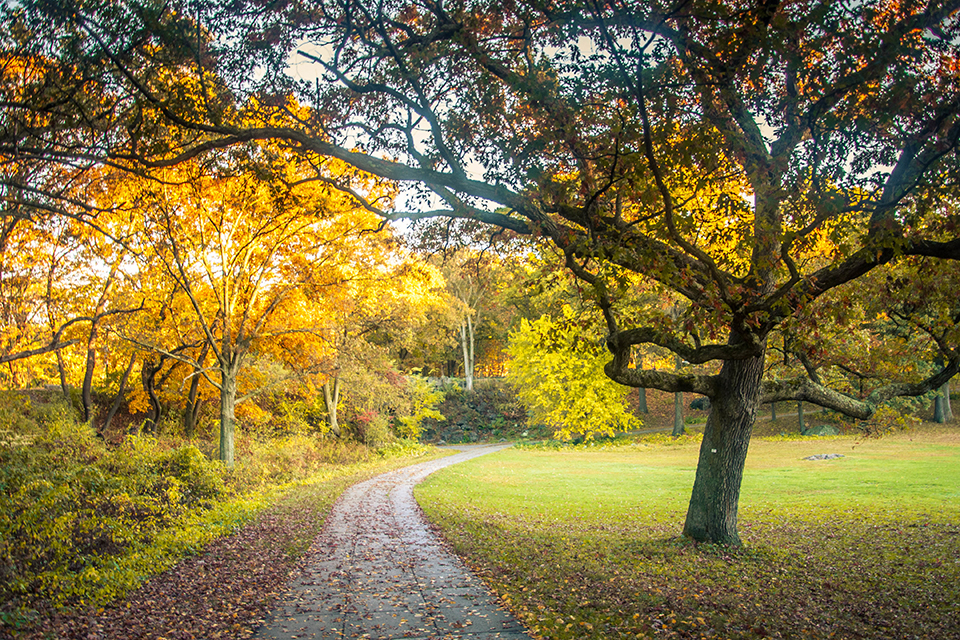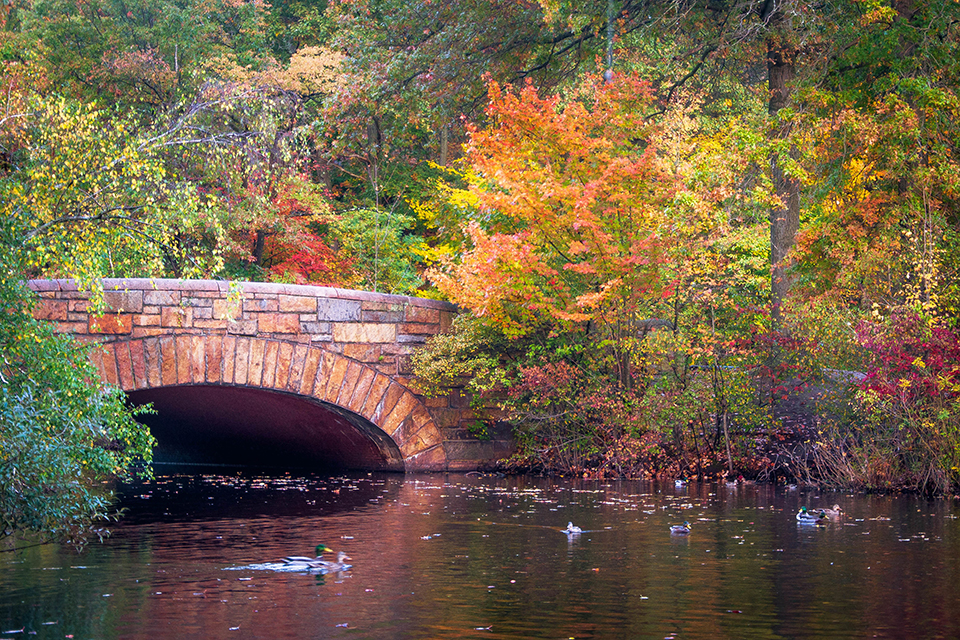Designed by Frederick Law Olmsted, Sr., and John Charles Olmsted, this 527-acre park is the largest in the 1,100-acre chain of parks known as the Emerald Necklace. Almost 75 years after thirteen acres of parkland were confiscated to construct the Lemuel Shattuck Hospital, the hospital’s scheduled demolition offers the opportunity for the city to reclaim that acreage for the public park—only 60 percent of which is currently freely accessible to the public.
History
Designed by Frederick Law Olmsted, Sr., and John Charles Olmsted, this 527-acre landscape, the largest park in Boston’s Emerald Necklace park system, was intended to serve as the city’s “central” park. Originally called West Roxbury Park, the public park was renamed to honor Benjamin Franklin in 1885. That same year, Fredrick Law Olmsted, Sr., and John Charles Olmsted completed the park’s “General Plan,” dividing the expansive space into two sections separated by Glen Lane: the Country Park, which assumed two-thirds of the park’s acreage, and the northern Ante Park, which was dedicated to active recreational uses.
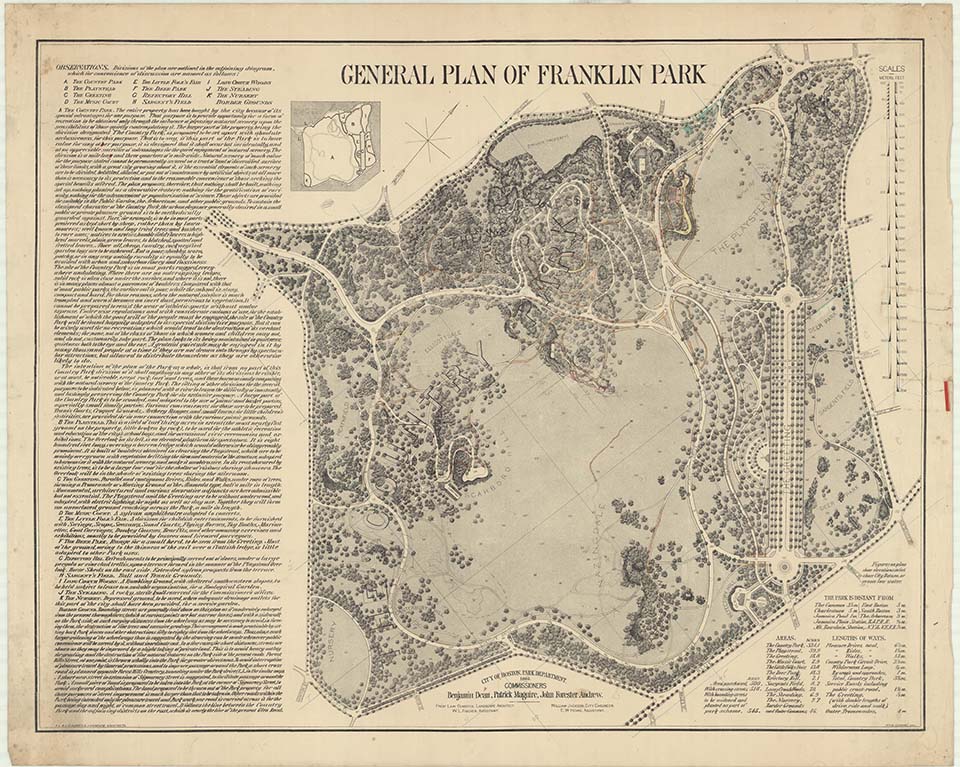 General Plan of Franklin Park, Boston, Massachusetts, 1885. Image courtesy of Frederick Law Olmsted National Historic Site.
General Plan of Franklin Park, Boston, Massachusetts, 1885. Image courtesy of Frederick Law Olmsted National Historic Site.
For the Country Park section, the designers embraced a simple approach, preserving a prominent feature described by Olmsted, Sr., as “a lovely dale gently winding between low wooded slopes, giving a broad expanse of unbroken turf, lost in the distance under scattered trees.” Scarboro Hill dominates the western portion of the Country Park and originally faced a meadow, “the Heathfield,” located on the opposite side of the curvilinear Circuit Drive. For the Ante Park the designers proposed creating a promenade, termed “the Greeting,” to extend from Blue Hill Avenue half-a-mile to the northwest as well as a 30-acre meadow, called “the Playstead.” While the promenade that was proposed in 1885 was never built, the Playstead opened in 1889 and served as athletic fields. A 500- by 300-foot terrace, “the Overlook,” faced with boulders found on site, was built along the space’s western edge. In 1891 the two Olmsteds revised their General Plan to include Scarboro Pond in the Country Park section, and the water feature was completed in 1893. By utilizing existing topography, ledges, native “Roxbury” puddingstone, and vegetation, as well as designing rustic stone and thatch structures, the designers achieved a cohesive, Picturesque quality throughout the park.
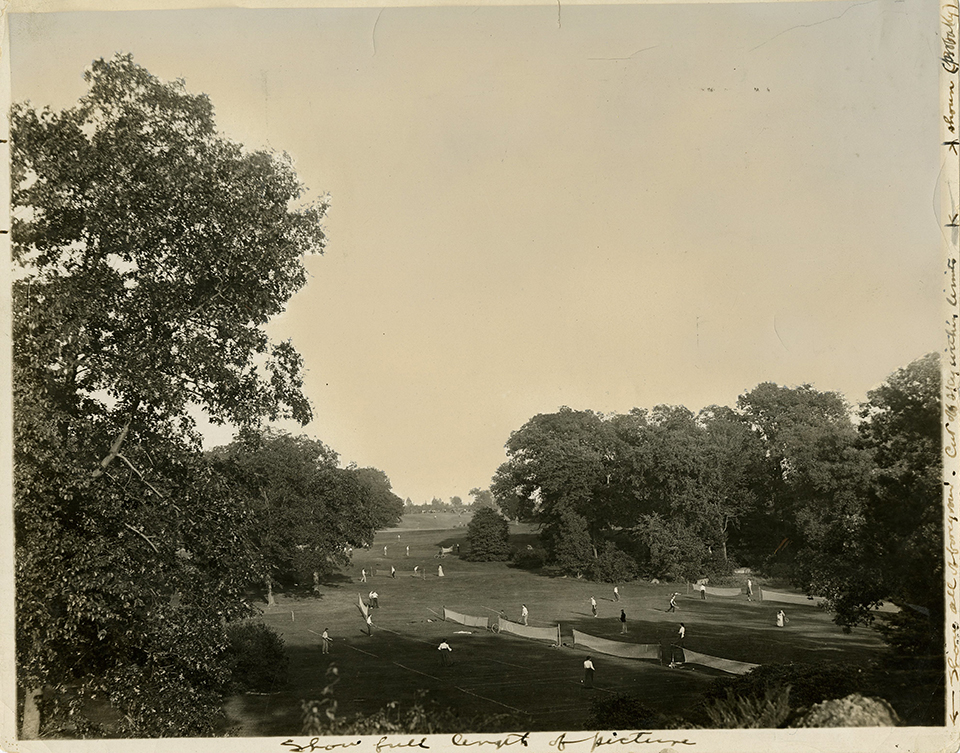 Tennis at Franklin Park, Boston, Massachusetts, Date Unknown. Image courtesy of Frederick Law Olmsted National Historic Site.
Tennis at Franklin Park, Boston, Massachusetts, Date Unknown. Image courtesy of Frederick Law Olmsted National Historic Site.
In 1896, five years after golfing was allowed in the park, a nine-hole course designed by Willie Campbell was completed, assuming the Country Park Meadow. The course became the first in the city of Boston and was among the earliest public courses in the nation. A year later, John Pettigrew was appointed superintendent for the Boston Parks Department. He not only altered the golf course, but modified the original Olmsted plan, thinning tree stands in “the Wilderness” section of the Country Park. In 1910 Arthur Shurcliff, a former employee of the Olmsted office (1896-1904), was appointed landscape architect to the Boston Parks Department and prepared a plan for the Franklin Park Zoo, which was completed in 1912. In 1925 he redesigned the park’s Peabody Circle drives. The Playstead Overlook Shelter, designed by Olmsted, Sr., burned down in 1948 and the area was further altered the following year with the construction of the Art Deco style George Robert White Schoolboy Stadium. In 1949 thirteen acres located in the southwest portion of the park, comprising “the Heathfield,” were ceded to the Commonwealth of Massachusetts and the Lemuel Shattuck Hospital was constructed on the site in 1954.
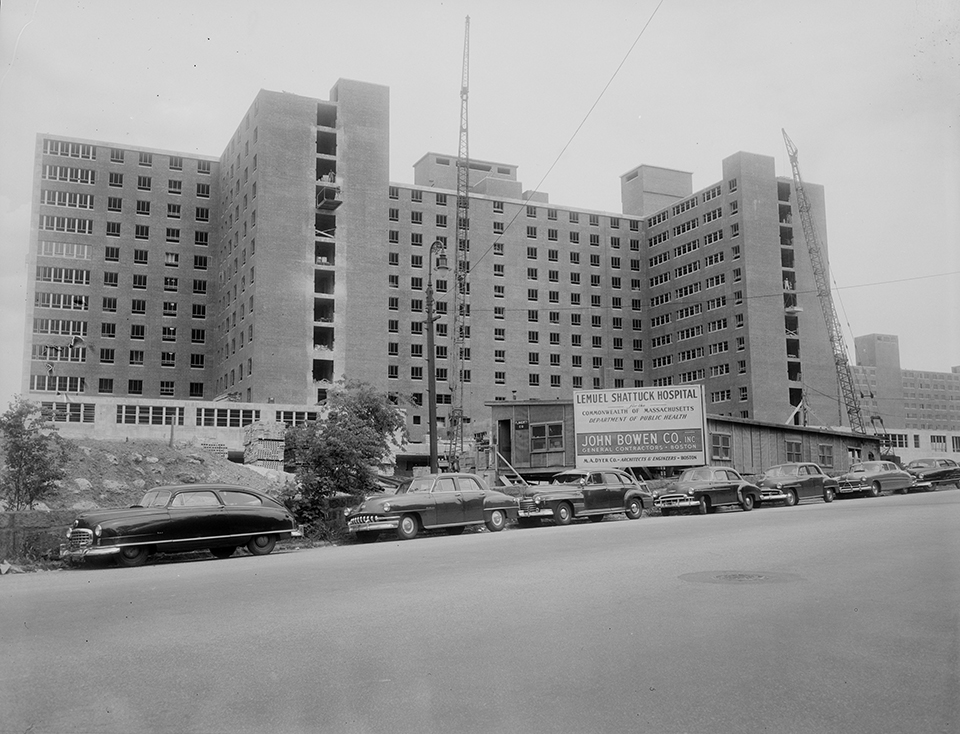 Lemuel Shattuck Hospital, Boston, Massachusetts, 1955. Image courtesy of Digital Commonwealth.
Lemuel Shattuck Hospital, Boston, Massachusetts, 1955. Image courtesy of Digital Commonwealth.
In 1971 several parks comprising the Emerald Necklace, including Franklin Park, were listed in the National Register of Historic Places. In 1978, the Franklin Park Coalition was founded and the landscape architecture firm Weinmayr Associates (now Weinmayr-Jay Assoc. Inc.) was hired by Boston Parks to prepare a Revised General Plan for the Franklin Park. In 1980, a report was published and the park became the third Emerald Necklace landscape (after Boston Common and Boston Public Garden) to be designated a Boston landmark. Franklin Park was however the first portion of the Emerald Necklace designed by Olmsted, Sr. to be granted such a designation. Enabled by the publicly supported Olmsted Historic Landscape Preservation Program, in 1984 the Halvorson Company (now Halvorson Tighe & Bond Studio) began the Franklin Park Master Plan. The plan, which was adopted in 1989 and published in 1991, resulted in a $32 million program overseen by the Massachusetts Department of Environmental Management, with support from then-Governor Michael Dukakis. The Necklace’s five core parks—Jamaica Pond, Olmsted Park, the Riverway, the Back Bay Fens, and Franklin Park—each received $1 million to advance essential work and to prepare preservation master plans. Child Associates later undertook historic preservation work at the park (1995-98), returning stadium parking to recreational lawn and reinstalling pathways that had been removed or altered. Pressley Associates rehabilitated the landscape and ruin at Schoolmaster Hill in the Country Park section in 1997, and rehabilitated park paths and trails in 2012. The City of Boston engaged Reed Hilderbrand, in collaboration with Agency Landscape + Planning and MASS Design Group, to provide another plan, called the “Franklin Park Action Plan” in 2019. Throughout the planning process the three local firms engaged local community members, holding multiple workshops. The soon-to-be-released plan will be followed by a public comment period.
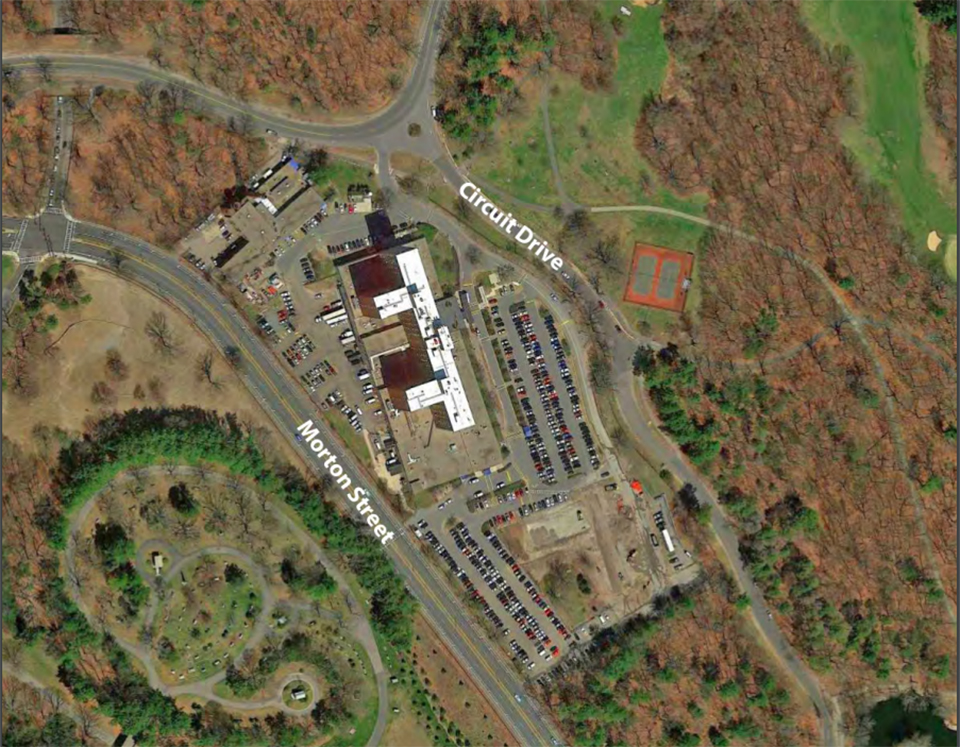
Image courtesy of Vision Plan: Redevelopment of the Shattuck Campus at Morton Street, February, 2020.
Threat
Over time, large sections of Franklin Park have been repurposed, leaving only 60 percent of its original acreage freely accessible to the public. In 2018, when the Massachusetts Department of Health and Human Services (DHHS) announced that the twelve-story Shattuck Hospital, located on thirteen acres of former Franklin Park land, would close, an opportunity emerged to return former park land back to the park, restore connectivity, and provide greenspace for local residents. Such as action is supported by The Standards and Criteria proposed in the 1980 Landmarks Commission Study, which sought to preserve both the “existing qualities” of the park, and “encouraged the removal of additions that have lessened the integrity of the property.” Though groups and individuals, including the Emerald Necklace Conservancy and two former Massachusetts governors, Michael Dukakis and Bill Weld, have advocated for returning the land for park use, the state would prefer to use the parcel for healthcare and supportive housing services.
Working with Northeastern University, the Emerald Necklace Conservancy determined that a nearby eighteen-acre site, also under public ownership, could serve as an alternative site for health and housing services, in combination with planned new uses included an electric bus facility. Nonetheless, in February 2020, the Commonwealth published a “Vision Plan for the Redevelopment of the Shattuck Campus at Morton Street,” calling for the site to be redeveloped. In June 2021 the Massachusetts Division of Capital Asset Management’s (DCAMM) Asset Management Board approved a Request for Proposals (RFP) without considering alternative sites or adequately engaging residents of the associated zoning implications. In June 2022, the RFP was issued, seeking a developer to lease the site from DCAMM for a period of 99 years. The response period for the RFP has ended and only one proposal was submitted, offered by the Boston Medical Center in collaboration with multiple partners.
In September 2022 Boston Mayor Michelle Wu released an Urban Forest Plan outlining seven strategies for supporting a “sustainable and equitable” urban forest in Boston. With the planned demolition of the Shattuck hospital, there is a unique opportunity for the mayor and her administration to follow through with the recommendations of her plan to make “space for trees” while simultaneously returning land to Franklin Park.
Recapturing the critical thirteen acres according to the Olmsted firm’s design intent would advance and build upon recent efforts that have reclaimed other portions of the Emerald Necklace. In 2017 the city of Boston, working with the U.S. Army Corps of Engineers, completed the first stage to daylight and restore a portion of the Muddy River, previously paved and used as a Sears parking lot, to serve as a riparian buffer, mitigating flooding, providing natural habitat, and improving access and unfettered connectivity to/between the Emerald Necklace parks for residents. Similarly, a current project led by the Emerald Necklace Conservancy and the Charlesgate Alliance aims to restore pedestrian and cyclist connections and revitalize Charlesgate Park, which was impaired by road and highway construction 70 years ago. Considered by many to be the first greenway in the world, the Emerald Necklace, and its contributing parks, is potentially eligible for listing as a World Heritage Site. As such, every effort should be made to recapture lost parkland and restore its ecological systems, and its critical connectivity to those neighboring communities it was intended to serve.
What You Can Do to Help
Write to public officials, including Boston mayor Michelle Wu, your local City Councilor, and your state legislators to urge that:
1. The Shattuck/Heathfield site be returned to Franklin Park and restored as publicly accessible open space in line with the original design intent of Fredrick Law Olmsted, Sr., and the Olmsted Firm.
2. The City of Boston consider alternative sites, better suited to serve and support health care and housing services.
Honorable Michelle Wu, Mayor, City of Boston
1 City Hall Square, Suite 500
Boston, MA 02201-2013
P: (617) 635-4500
On November 8, 2022, Massachusetts voters will elect a new Governor. Please monitor the results of the election and contact the incoming Governor to express your support of retuning the Shattuck/Heathfield site to Franklin Park.
Support the Emerald Necklace Conservancy:
1. Donate to the Conservancy
2. Sign up to receive Conservancy email updates
3. Learn more about the project on the Conservancy’s website
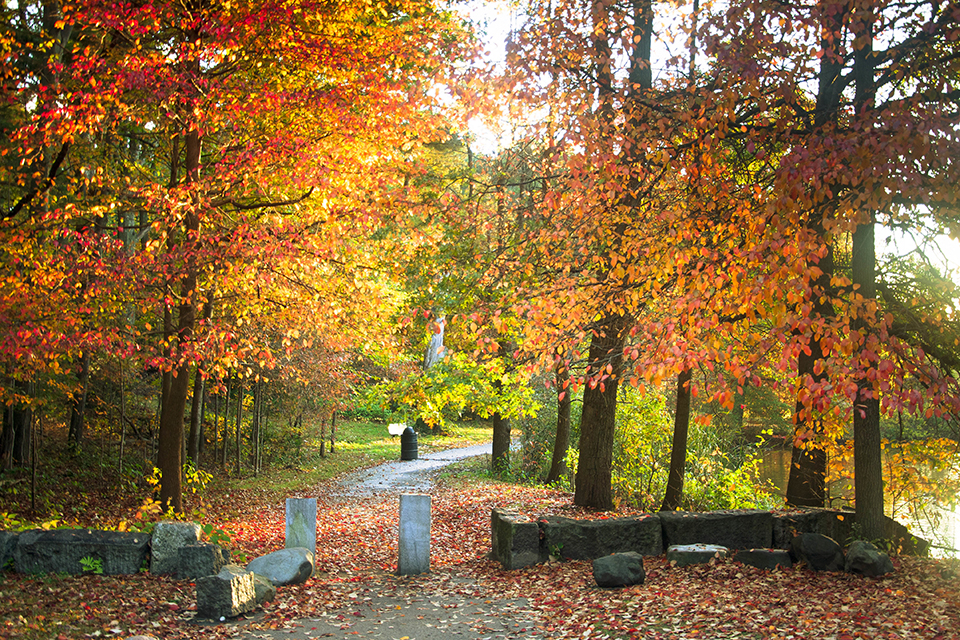
-
Photo by Sarah Nichols. Courtesy of Flickr.
